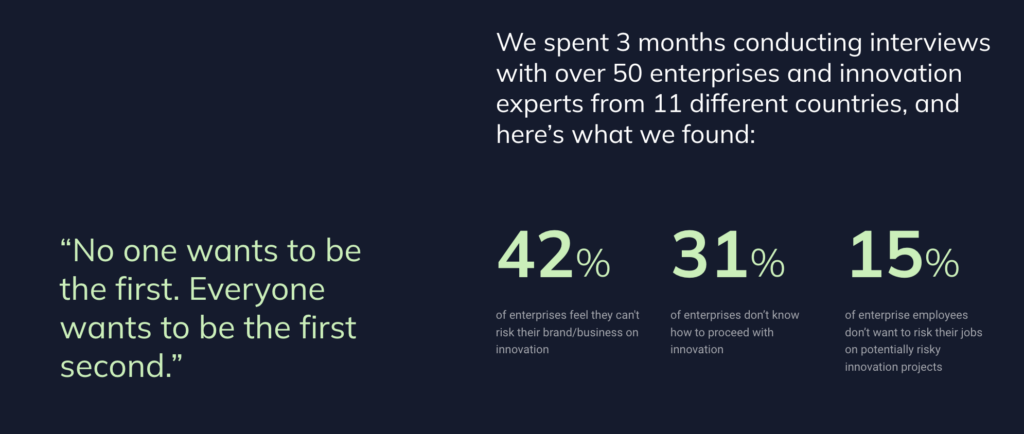
Back in 1958, S&P 500 corporations had an average stay of 61 years. But since 2000, 52% of enterprises in the Fortune 500 have either “gone bankrupt, been acquired, or ceased to exist” due to digital transformation.*
The data shows that – in the Digital Age – a corporate enterprise’s survival depends on its ability to innovate.
But “innovation” is one of those buzzwords that’s been so overused, it’s practically lost its meaning. So, what is corporate innovation really?
What is corporate innovation?
Simply put, innovation is creative problem-solving. It’s outside-the-box thinking.
Corporate innovation gets complicated because large corporate enterprises tend to like their boxes. After all, boxes keep everything nice and tidy. But, as the COVID-19 pandemic has made abundantly clear, innovation is not a luxury companies can afford to neglect.
Innovation is no longer about gaining a competitive edge: it’s essential if a corporate enterprise wants to stay relevant in a rapidly evolving world. It is mission-critical to build better products, improve organizational efficiency, and retain customers.
Of course, it’s difficult for enterprises to invent and iterate fast enough to achieve these goals. That’s why startup partnerships are so invaluable to keeping enterprises ahead of the curve.
The Key to Corporate Innovation is Startup Partnerships
Enterprises are built on bureaucracy, and organization innovation ideas stagnate in bureaucratic environments. Startups, on the other hand, create the perfect environment for innovation to thrive. They’re designed to move at lightning speed and think outside the box to solve the problems enterprises face on a daily basis.
What might take a startup 6 months could cost corporate enterprises years of development with no guaranteed results. So, by partnering with a startup, enterprises can chug along with business as usual while their newfound partner tackles their problems from an entirely new perspective.
Problem solved, right!? Wrong.
Working with a startup has its own set of challenges. After all, ideation is only half the battle.
The path to implementing innovative ideas is far from clear. Not to mention, riddled with obstacles.
The Top 5 Obstacles to Corporate Innovation
In the 5 years, we’ve worked in the field of digital transformation, we’ve witnessed countless enterprises get bogged down by bureaucracy and fall behind the times. We’ve seen startups with genuinely revolutionary ideas wither on the vine because their sales cycle outstripped their funding.
But once we settled into our San Francisco offices, we realized that the biggest obstacles to corporate innovation weren’t financial, geographic, cultural, or even language barriers. These are all significant hurdles of course – but they are clearly defined and (in most cases) can be overcome with the help of modern technology.
No, the real challenges are much bigger, spanning all industries and afflicting even the most trailblazing global enterprises. Here are the 5 most common obstacles we’ve encountered in our work matching enterprises with their startup soulmates:
1- Enterprises don’t want to run the risk of innovating.
In the process of building entrapeer, we interviewed 60+ C-level executives, founders, innovation experts, and other key stakeholders. We dug deep to uncover their pain points and identify the real obstacles that stood in the way.
Here’s what we found:

Despite their wealth of resources, global corporations still struggle to innovate because they’re risk-averse.
While C-suite execs might say they want to do what no one has dared before, they also want proof that their gamble will pay off. In other words: that the new technology they’re planning to invest in will work at scale.
Of course, once a startup has that kind of proof it’s usually too late – their innovative idea is already widespread or it’s been swooped up by another enterprise with the prescience to invest early.
The truth is that risk is inevitable. If enterprises don’t take a chance on new tech, they risk being left in the dust by their more daring competitors. But risk can be calculated.
Which brings us to our second obstacle…
2- Startups don’t have verifiable evidence to prove product readiness.
Enterprises want to innovate, but too many corporations have been burned by startups that overpromise and underdeliver. As such, enterprises need more than a startup’s word to risk investing in new technologies.
But how is a startup supposed to prove that their product can yield the results an enterprise expects when they’ve never had the capital or resources to test their product at such a scale?
The fact of the matter is that an enterprise can’t know a new technology will work for their organization until they try it. But they can look at a startup’s track record, read case studies, and explore use cases in different fields that face similar challenges.
If only it were that easy.
The problem is that all this background information is hard to find. Or if it is easily searchable it’s likely:
a. Heavily biased
b. Unverifiable
c. Difficult to digest – After all, there is no standard case study format. Most wind up being too vague, too technical, or entirely divorced from context, making the information contained within pretty much meaningless.
Case studies tend to paint their authors (i.e. the startups) in a rosy light. Even the data you find on most market intelligence platforms is questionable because there’s no third-party verification.
Up until now, the best way to get an accurate picture of a startup’s past success and current capabilities was to schedule a call and get the facts straight from the proverbial horse’s mouth. But even that has its own challenges.
3- Poor communication means sales cycles drag on but lead nowhere.
All too often, the real benefits of technology get lost beneath a mountain of features and marketing lingo. Or a startup doesn’t want to risk losing a potential customer, so they might – with the best of intentions – promise the moon rather than set realistic expectations.
Simultaneously, enterprises often don’t do the research to express exactly what they need to be done, the resources they have available, and what they expect of the startups they scout.
The result is that startups find themselves months into sales conversations with an enterprise lead, only to discover that the company doesn’t meet their basic requirements for a POC project. Or enterprises learn that the startup’s technology is incompatible with the needs of their organization.
All of this poor communication leads to obstacle #4…
4- Lack of transparency leads to distrust on both sides.
Once the illusion of a perfect partnership is shattered, trust is lost on both sides. That is if there was trust to begin with.
As mentioned above, a lot of enterprises have been burned in the past. Just as many startups have been strung along with conversations that lead nowhere – costing them precious time in the process.
The result is that each party enters the innovation conversation fighting an uphill battle to earn the other’s trust – but both sides are reluctant to show their hands.
Startups don’t want to share too much about how their tech works for fear that the corporation will turn around and (try to) reproduce the solution in-house. Meanwhile, enterprises can’t share sensitive information until NDAs are signed, but they don’t want to trigger that whole bureaucratic process until they believe they’ve found the right startup.
So, both parties wind up in a standoff that only breeds further distrust.
5- Without a clear path forward, enthusiasm fizzles out.
Assuming both enterprise and startup have been able to navigate this minefield of negotiations, they come to the make-or-break moment:
Do they try and make things work as partners in this innovation initiative? Or do they part ways and cut their losses?
It all comes down to whether or not both parties have a clear process in place to guide their first steps. Does the startup have an onboarding protocol? Does the enterprise know exactly who needs to be brought into the project and debriefed? Can this whole process be streamlined so there are as few meetings as possible before work can get started (and enterprises can start seeing results)?
If these conversations drag on too long, enthusiasm inevitably wanes until one party ghosts the other (or both parties seemingly vanish into thin air). Inaction is the kiss of death for innovation.
These obstacles paint a pretty bleak picture. But there’s good news.
Innovation doesn’t have to be so risky or riddled with pitfalls.
We know from firsthand experience.
Entrapeer: The All-In-One Corporate Innovation Platform
We’ve spent the past 5 years perfecting our innovation matchmaking process, so we know that the key to dissolving all of these obstacles is verifiable evidence. Presented up front and by a third party.
That’s why we created entrapeer. The all-in-one corporate innovation platform revolutionizing how enterprises can interact with startups.
Entrapeer is a pioneering evidence-based search engine designed to facilitate corporate enterprise innovation by connecting with the right trailblazing startups. We do so by collecting and verifying use-case specific evidence from startups, giving enterprises the evidence they need to confidently invest in innovation through our corporate innovation platform.
But enough about us, because this is really all about you. Everything we’ve built is designed to make the most up-to-date data, more accessible – so innovation can flourish. So you can move past tedious sales cycles or tech scouting, and get back to doing the creative, trailblazing work you love.
Why not give our platform a shot and sign up for your free trial? Discover how our corporate innovation services can help your organization.
FAQs
What is a corporate innovation platform?
A corporate innovation platform is a specialized tool designed to facilitate and streamline innovation within large enterprises. It connects corporations with startups and innovation experts to foster collaboration, ideation, and implementation of innovative solutions.
How can corporate innovation services help my business?
Corporate innovation services help businesses stay competitive by providing expertise, resources, and strategies to drive innovation. They support the identification of new opportunities, development of innovative solutions, and implementation of best practices to enhance organizational efficiency and product offerings.
Why are startup partnerships important for corporate innovation?
Startup partnerships are crucial because startups bring fresh perspectives, agility, and innovative solutions that large enterprises may struggle to develop internally. By collaborating with startups, enterprises can accelerate their innovation processes and address challenges more effectively.
What are the benefits of using a corporate innovation platform like entrapeer?
Using a corporate innovation platform like entrapeer provides access to a network of vetted startups, streamlined collaboration processes, and verified evidence to support investment decisions. This leads to faster innovation cycles, reduced risks, and more successful implementation of innovative solutions.
How do I get started with entrapeer’s corporate innovation platform?
To get started with entrapeer’s corporate innovation platform, simply sign up for a free trial on our website. Our platform will guide you through the process of connecting with relevant startups and accessing the evidence you need to drive successful innovation initiatives.

